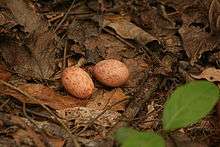Pauraque
| Pauraque | |
|---|---|
 | |
| Common pauraque Common Pauraque song, recorded in Peru | |
| Scientific classification | |
| Kingdom: | Animalia |
| Phylum: | Chordata |
| Class: | Aves |
| Superorder: | Neoaves |
| (unranked) | Cypselomorphae |
| Order: | Caprimulgiformes |
| Family: | Caprimulgidae |
| Genus: | Nyctidromus Gould, 1838 |
| Species: | N. albicollis |
| Binomial name | |
| Nyctidromus albicollis (Gmelin, 1789) | |
The pauraque (Nyctidromus albicollis) – also called the common pauraque to distinguish it from similar species – is a nightjar species, one of two birds in the genus Nyctidromus. It breeds in the subtropical and tropical of the New World, and except for northernmost birds it is largely resident all year round.[2]
Description

This medium-sized nightjar is 8.7–11 in (22–28 cm) long and has two colour morphs, the plumage being variegated greyish-brown or rufous-brown. It is long-tailed and has broad rounded wings. The buff 'eyering' and 'facial stripe' contrast with the reddish sides of the face.[2]
The adult male pauraque has a white band near the wing tips, and the outer tail feathers are mainly white. The female's wing band is narrower and the white in the outer tail is more restricted. There are seven subspecies of the pauraque, differing in size and greyness.[2]
The male pauraque's song is very variable, but includes a whistled weeeow wheeooo ("who-r-you"), soft puk puk and a whip given in the courtship flight as he flutters around the female. Her call is a rapid succession of whip sounds.[2]
Distribution and ecology
The breeding range of the common pauraque extends from southern Texas to the lower Paraná River region. Most populations are all-year residents, although the U.S. breeders (N. a. merrilli) may winter in eastern Mexico.[2]
At the southern end of its range, subspecies N. a. derbyanus ranges from central and southern Brazil into the adjacent parts of Bolivia, and through Paraguay into Argentina and Uruguay. Even the southernmost birds seem to be nonmigratory, but at the limit of its range the species is only patchily distributed. For example, it is not recorded to breed in Entre Ríos Province (Argentina) and it is scarce in Rio Grande do Sul (Brazil); about its presence in Uruguay likewise little is known, except that a population of some size is found along the Yaguarón River in the Cuchilla de Mangrullo region.[3]

It is found in open woodland/grassland habitats, but also scrubland and crop fields. This species has long legs (by nightjar standards) with bare tarsi, and is more terrestrial than most of its relatives. If disturbed, it will sometimes run rather than fly, and it frequently rests on roads and tracks. In general it prefers mixed habitat which offers densely vegetated hiding places – ideally forest – for the day, as well as open landscape – perhaps even rivers or wetlands – to hunt at night. The pauraque is nocturnal, like other nightjars, and starts to fly at dusk. Like its relatives, it feeds on insects caught in flight, usually by flycatching from a low perch, but also by foraging over open ground.[2][4]
No nest is made; the two elongated and elliptical pinkish eggs are placed upon the bare ground or leaf litter. Not globally threatened, it is considered a Species of Least Concern by the IUCN.[1] Being an adaptable species that will tolerate human disturbance of habitat well, the pauraque has actually benefitted from limited deforestation. Logging creates areas of low and secondary growth in which the birds are able to hunt more efficiently. However, it will of course abandon heavily built-up or clear-cut locales, and, in addition, it is very vulnerable to predation by feral dogs and cats, disappearing from areas where these pests are abundant.[5]
References
- 1 2 BirdLife International (2012). "Nyctidromus albicollis". IUCN Red List of Threatened Species. Version 2013.2. International Union for Conservation of Nature. Retrieved 26 November 2013.
- 1 2 3 4 5 6 Cleere, Nigel (1998). Nightjars: a Guide to Nightjars and Related Nightbirds. Nr. Robertsbridge (East Sussex): Pica Press. ISBN 1-873403-48-8.
- ↑ Azpiroz, Adrián B.; Menéndez, José L. (2008). "Three new species and novel distributional data for birds in Uruguay". Bull. B.O.C. 128 (1): 38–56.
- ↑ Accordi, Iury Almeida; Barcellos, André (2006). "Composição da avifauna em oito áreas úmidas da Bacia Hidrográfica do Lago Guaíba, Rio Grande do Sul" [Bird composition and conservation in eight wetlands of the hydrographic basin of Guaíba lake, State of Rio Grande do Sul, Brazil]. Revista Brasileira de Ornitologia (in Portuguese and English). 14 (2): 101–115.
- ↑ Ingels, J.; Oniki, Y.; Willis, E.O. (1999). "Opportunistic adaptations to man-induced habitat changes by some South American Caprimulgidae" (PDF). Revista Brasileira de Biologia (in English and Portuguese). 59 (4): 563–566. doi:10.1590/S0034-71081999000400005.
- de Lyra-Neves, Rachel M.; Oliveira, Maria A.B.; Telino-Júnior, Wallace R.; dos Santos, Ednilza M. (2007). "Comportamentos interespecíficos entre Callithrix jacchus (Linnaeus) (Primates, Callitrichidae) e algumas aves de Mata Atlântica, Pernambuco, Brasil" [Interspecific behaviour between Callithrix jacchus (Linnaeus) (Callitrichidae, Primates) and some birds of the Atlantic forest, Pernambuco State, Brazil] (PDF). Revista Brasileira de Zoologia (in Portuguese and English). 24 (3): 709–716. doi:10.1590/S0101-81752007000300022.
External links
| Wikimedia Commons has media related to Nyctidromus albicollis. |
| Wikispecies has information related to: Nyctidromus albicollis |
- "Pauraque media". Internet Bird Collection.
- Pauraque Stamps for Suriname and Venezuela at bird-stamps.org
- Common Pauraque photo gallery at VIREO (Drexel University)
- Common pauraque species account at NeotropicalBirds (Cornell University)
